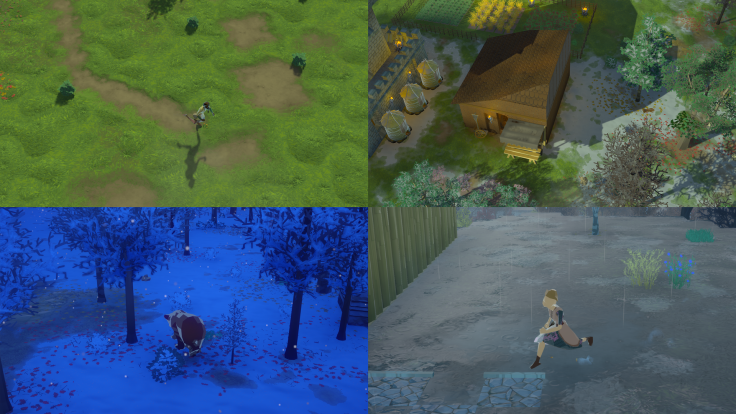Temperature and environmental effects are two important aspects of Going Medieval that received an overhaul in the recent patch, which aims at improving realism. Read further to learn more.
Changes to the Temperature System
The temperature in Going Medieval is now more realistic than ever before. Humans, animals, and trees are just some of the things that can provide heat. These heat sources will give warmth to the nodes around them and they're made in such a way that allows for even distribution through open doors and windows.
Just like in the real world, opening and closing doors while it's cold outside will let cold air in. This, in turn, affects the temperature inside your castle.
Furthermore, temperature can accumulate over time. When you have a room with high insulation, for example, you can leave the room and it will get warmer on its own as time progresses.
Here are the other changes to the new temperature system:
- Braziers now have 3 levels of heating (low, medium, and high) which will influence their fuel consumption. The default setting is medium and changing to another level is instant.
- Settlers will not choose idle/eating/sleeping locations that are outside of the comfortable temperature (-8 to 34C).
- Beds located in temperatures outside of the comfortable range will be disabled.
- Map type influences temperature. Mountain maps have colder summers and winters, while valley winters are milder by comparison.
Environmental Effects Overhaul
While the changes to the temperature system are more impactful, the tweaks to environmental effects are still welcome since they help make the game look even prettier.
In Update 9, snow now accumulates when it falls. Additionally, animals and settlers walking in snowy areas will leave trails behind.
It's important to note that snow melts at higher temperatures. When it does, the melted parts turn into wetness, which does not dry up when it's still surrounded by snow. So, if you want to clean it up thoroughly, you have to remove the snow first.
You can find the other changes related to environmental effects and temperature below:
Sunlight
- Sunlight provides a heating effect.
- Settlers will get heat stroke when in the sun for a long period of time. Having certain apparel, like a wide hat on their head, will help protect them from the heat stroke effect.
- Sunlight's strength is determined by the angle of the sun.
- Shadows created by sunlight will offer cooler spots.
- During winter, the shadows of dead trees will not affect temperature change.
- Sunlight bouncing off the materials will create diffuse light. This allows for plant growth within inside areas but can also be observed in-game.
Influence on Plants
- A tree becomes stunted if it:
- Is surrounded by more than 2 x walls.
- Has more than 2x trees around them (the player needs to sow them row by row in order to make the most out of the tree sowing now.
- Has a roof or floor immediately over it in the layer above.
Day/Night Cycle
- In the summertime, the sun will rise around 4 AM and go down around 9 PM.
- During the winter season, sunrise will occur around 8 AM and sunset around 3 PM.
- The angle of the sun is dictated by the seasons.
- The 6th of Winter will be the longest night in the game.
- The 6th of Summer will have the longest day in the game.
So, what can you say about the temperature and environmental effects overhaul in Going Medieval Update 9?















![[EG April 19] Best 'Stardew Valley' Mods That Will Change](https://d.player.one/en/full/226012/eg-april-19-best-stardew-valley-mods-that-will-change.png?w=380&h=275&f=955520b8313253ee3c39c791f6210f38)



